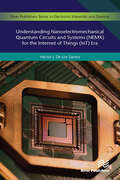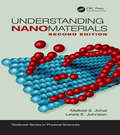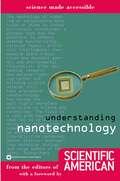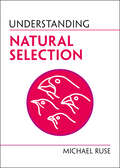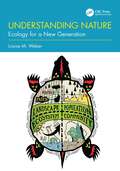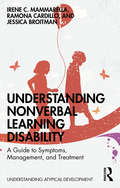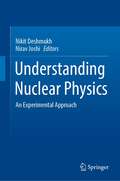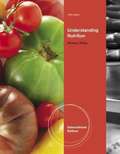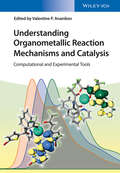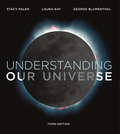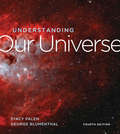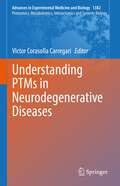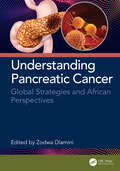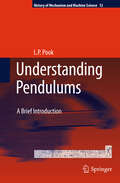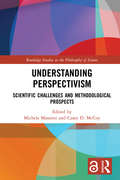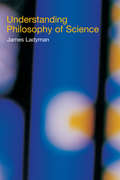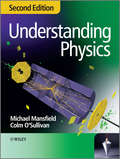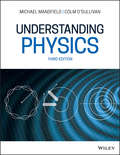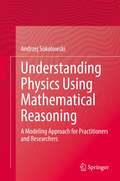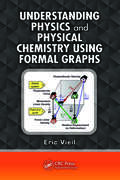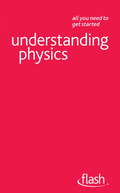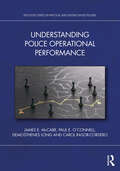- Table View
- List View
Understanding NMR Spectroscopy
by James KeelerThis text is aimed at people who have some familiarity with high-resolution NMR and who wish to deepen their understanding of how NMR experiments actually 'work'. This revised and updated edition takes the same approach as the highly-acclaimed first edition. The text concentrates on the description of commonly-used experiments and explains in detail the theory behind how such experiments work. The quantum mechanical tools needed to analyse pulse sequences are introduced set by step, but the approach is relatively informal with the emphasis on obtaining a good understanding of how the experiments actually work. The use of two-colour printing and a new larger format improves the readability of the text. In addition, a number of new topics have been introduced: How product operators can be extended to describe experiments in AX2 and AX3 spin systems, thus making it possible to discuss the important APT, INEPT and DEPT experiments often used in carbon-13 NMR. Spin system analysis i.e. how shifts and couplings can be extracted from strongly-coupled (second-order) spectra. How the presence of chemically equivalent spins leads to spectral features which are somewhat unusual and possibly misleading, even at high magnetic fields. A discussion of chemical exchange effects has been introduced in order to help with the explanation of transverse relaxation. The double-quantum spectroscopy of a three-spin system is now considered in more detail. Reviews of the First Edition "For anyone wishing to know what really goes on in their NMR experiments, I would highly recommend this book" - Chemistry World "...I warmly recommend for budding NMR spectroscopists, or others who wish to deepen their understanding of elementary NMR theory or theoretical tools" - Magnetic Resonance in Chemistry
Understanding Nanoelectromechanical Quantum Circuits and Systems (NEMX) for the Internet of Things (IoT) Era
by Héctor J. SantosThe operational theme permeating most definitions of the IoT concept, is the wireless communication of networked objects, in particular, smart sensing devices and machines, exchanging data a la Internet. In this book, a detailed look is taken at the fundamental principles of devices and techniques whose exploitation will facilitate the development of compact, power-efficient, autonomous, smart, networked sensing nodes underlying and encompassing the emerging IoT era.The book provides an understanding of nanoelectromechanical quantum circuits and systems (NEMX), as exemplified by firstly the uncovering of their origins, impetus and motivation, and secondly by developing an understanding of their device physics, including, the topics of actuation, mechanical vibration and sensing. Next the fundamentals of key devices, namely, MEMS/NEMS switches, varactors and resonators are covered, including a wide range of implementations. The book then looks at their energy supply via energy harvesting, as derived from wireless energy and mechanical vibrations. Finally, after an introduction to the fundamentals of IoT networks and nodes, the book concludes with an exploration of how the NEMX components are encroaching in a variety of emerging IoT applications.
Understanding Nanomaterials, Second Edition (Textbook Series in Physical Sciences)
by Malkiat S. Johal Lewis E. JohnsonPraise for the first edition"clear and informative” ?Chemistry World The authors provide the perfect training tool for the workforce in nanotech development by presenting the fundamental principles that govern the fabrication, characterization, and application of nanomaterials. This edition represents a complete overhaul, giving a much more complete, self-contained introduction. As before, the text avoids excessive mathematical detail and is written in an easy to follow, appealing style suitable for anyone, regardless of background in physics, chemistry, engineering, or biology. The organization has been revised to include fundamental physical chemistry and physics pertaining to relevant electrical, mechanical, and optical material properties. Incorporates new and expanded content on hard materials, semiconductors for nanoelectronics, and nonlinear optical materials. Adds many more worked examples and end-of-chapter problems. Provides more complete coverage of fundamentals including relevant aspects of thermodynamics, kinetics, quantum mechanics, and solid-state physics, and also significantly expands treatment of solid-phase systems. Malkiat S. Johal is a professor of physical chemistry at Pomona College, and earned his doctorate in physical chemistry at the University of Cambridge, UK. Lewis E. Johnson is a research scientist at the University of Washington, where he also earned his doctorate in chemistry and nanotechnology.
Understanding Nanotechnology
by The Editors of Scientific AmericanTaken from the Greek, nano means 'one billionth part of' a whole; or very, very small. Nanotechnology is the next step after miniaturization. This book explores the cutting edge of a new technology that will find usage in almost every single aspect of modern society.
Understanding Natural Selection (Understanding Life)
by Michael RuseNatural selection, as introduced by Charles Darwin in the Origin of Species (1859), has always been a topic of great conceptual and empirical interest. This book puts Darwin's theory of evolution in historical context showing that, in important respects, his central mechanism of natural selection gives the clue to understanding the nature of organisms. Natural selection has important implications, not just for the understanding of life's history – single-celled organism to man – but also for our understanding of contemporary social norms, as well as the nature of religious belief. The book is written in clear, non-technical language, appealing not just to philosophers, historians, and biologists, but also to general readers who find thinking about important issues both challenging and exciting.
Understanding Nature: Ecology for a New Generation
by Louise M. WeberUnderstanding Nature is a new kind of ecology textbook: a straightforward resource that teaches natural history and ecological content, and a way to instruct students that will nurture both Earth and self. While meeting the textbook guidelines set forth by the Ecological Society of America, Understanding Nature has a unique ecotherapy theme, using a historical framework to teach ecological theory to undergraduates. This textbook presents all the core information without being unnecessarily wordy or lengthy, using simple, relatable language and discussing ecology in ways that any student can apply in real life. Uniquely, it is also a manual on how to improve one’s relationship with the Earth. This is accomplished through coverage of natural history, ecology, and applications, together with suggested field activities that start each chapter and thinking questions that end each chapter. The book includes traditional ecological knowledge as well as the history of scientific ecological knowledge. Understanding Nature teaches theory and applications that will heal the Earth. It also teaches long-term sustainability practices for one’s psyche. Professor Louise Weber is both an ecologist and a certified ecopsychologist, challenging ecology instructors to rethink what and how they teach about nature. Her book bridges the gap between students taking ecology to become ecologists and those taking ecology as a requirement, who will use the knowledge to become informed citizens.
Understanding Nonverbal Learning Disability: A Guide to Symptoms, Management and Treatment (Understanding Atypical Development)
by Jessica Broitman Irene C. Mammarella Ramona CardilloThis essential book offers an accessible, evidence-based guide to Nonverbal Learning Disability (NVLD) informed by the most current research, and clinical and educational practice. It provides a thorough explanation of the science behind the condition, alongside ideas, support, and practical tips for managing the everyday challenges of the disorder at school and in family life. Mammarella, Cardillo, and Broitman describe the main characteristics of the condition from both theoretical and practical points of view, as well as examining the similarities and differences between NVLD and other neurodevelopmental disorders. They explore the cognitive and academic weaknesses and strengths of children with NVLD, and the emotional and social difficulties they may experience. The book also provides a systematic review of scientific studies in this field whilst focusing on issues of diagnostic criteria, as well as assessment and intervention strategies. Practical examples are given for teachers and parents to help support children with NVLD in improving their visuospatial and motor skills, as well as peer-social relations, and in promoting the child’s individual abilities. Understanding Nonverbal Learning Disability is essential reading for parents and practitioners in clinical and educational psychology, and health and social care, and students in these fields.
Understanding Nuclear Physics: An Experimental Approach
by Nirav Joshi Nikit DeshmukhThis book provides a unique approach to understand the Nuclear Physics, especially from the experimental end. The highlight of this book is that special care has been taken to provide more experimental information, considering real experimental data which has been published in several journals. Special experimental focus is given to methodologies involving: offline gamma counting and online particle detection. The book provides information about recent developments in accelerators, overview of the detectors and concise information of associated electronics, data acquisition systems and computers for data analysis.
Understanding Nutrition
by Ellie Whitney Sharon Rady RolfesThe updated 16th Edition of Whitney/Rolfe's bestselling UNDERSTANDING NUTRITION presents the core information of an introductory nutrition course for majors, with active learning that prepares students for their future careers. An overarching goal of the text is to help readers learn to distinguish valid nutrition information from misinformation. In addition to providing accurate information, the text encourages readers to understand the connections between concepts, evaluate the pros and cons of an argument, detect inconsistencies and errors, solve problems, and identify the relevance of information.
Understanding Nutrition (Thirteenth Edition)
by Eleanor Noss Whitney Sharon Rady RolfesThis best-selling introductory nutrition text is praised for its approachable narrative, engaging presentation, and careful explanations. The new Thirteenth Edition of Whitney and Rolfes' UNDERSTANDING NUTRITION takes the study of nutrition to a new level with an integrated pedagogy and an emphasis on active learning, assignable content, and integrated resources. From its beautiful and carefully developed art program to its strong science base, contemporary coverage, and market-leading supplements, the Thirteenth Edition of UNDERSTANDING NUTRITION connects with its readers and continues to set the standard for texts in this market. This text includes 20 chapters beginning with core nutrition topics, such as diet planning, macronutrients, vitamins and minerals, and following with chapters on diet and health, fitness, life span nutrition, food safety, and world hunger. UNDERSTANDING NUTRITION connects with students--engaging them as it teaches the basic concepts and applications of nutrition.
Understanding Oil and Gas Shows and Seals in the Search for Hydrocarbons
by John DolsonThe book covers in detail the ways to understand how to use oil and gas show information to find hydrocarbons. It covers the basics of exploration methodologies, drilling and mud systems, cuttings and mud gas show evaluation, fundamental log analysis and pitfalls to log-calculated water saturations. A complete overview of the use of pressures to understand traps and migration, hydrodynamics, and seal and reservoir quantification using capillary pressure to underpin important fundamental concepts every petroleum geologist must know. Techniques for quickly generating pseudo-capillary pressure curves from simple porosity/permeability data, with examples of how to build the spreadsheets in Excel, provide quick and simple ways to determine where a test or sample may be in a trap based on its water saturation and rock properties. In addition, a complete treatment of fluid inclusion analysis and fluid inclusion stratigraphy to map migration pathways and recognize by-passed or near miss pay zones is covered and illustrated with numerous examples. Lastly, petroleum systems modeling and fundamental source rock geochemistry is discussed at depth, particularly in the context of unconventional source rock evaluation and screening tools for entering new plays. The promise, perils, and pitfalls of understanding and modeling migration in 3 dimensional space with modern software is examined with an eye toward how to visualize hydrocarbon shows as a means of validating or rejecting the model results. Perhaps more importantly, the book is heavily illustrated with numerous examples and case histories from the author's 37 years of exploration experience. The topics covered in this book will give any young geoscientist a quick start on a successful career and serve as a refresher for the more experienced explorers.
Understanding Organometallic Reaction Mechanisms and Catalysis
by Valentin P. AnanikovThis handbook and ready reference highlights the latest insights and developments in the studies of important organometallic, homogeneous, and heterogeneous reaction mechanisms. It adopts a unique approach, exemplifying how to use experiments, spectroscopic investigations, and computational methods to reveal reaction pathways and molecular structures of catalysts, rather than concentrating solely on one discipline. The result is a deeper understanding of the underlying reaction mechanisms and correlation between molecular structure and reactivity. The contributions represent a wealth of first-hand information from renowned experts working in all major disciplines, covering such topics as activation of small molecules, palladium catalysis, cross-coupling reactions, and nanoparticle synthesis. With the knowledge gained, the reader will be able to improve existing reaction protocols and rationally design more efficient catalysts or selective reactions.An indispensable source of information for synthetic, analytical, and theoretical chemists in academia and industry alike.
Understanding Our Universe
by Laura Kay Stacy Palen George BlumenthalResearch shows that active learning supports deeper, long-term understanding. The Third Edition text and media package gives students more opportunities to interact with astronomy--both in real life and online. The new edition provides all the resources you need to make it easy to incorporate active learning into the classroom.
Understanding Our Universe (Fourth Edition)
by Stacy Palen George BlumenthalThe most innovative resources for the most important course Stacy Palen knows that introductory astronomy may be the only science course some students take in their college careers, so it’s their best chance to develop scientific literacy. Education research shows that the best way to attain scientific literacy is through active learning. Understanding Our Universe, Fourth Edition makes it easier for instructors to help students understand the concepts and learn to value science by providing activities that can be used before, during, and after class. By expanding her pedagogy to include What If scenarios and What an Astronomer Sees figure captions, Stacy helps students build scientific literacy and to think critically about science in the media. This purchase offers access to the digital ebook only.
Understanding PTMs in Neurodegenerative Diseases (Advances in Experimental Medicine and Biology #1382)
by Victor Corasolla CarregariThis new volume, a part of the Proteomics, Metabolomics, Interactomics and Systems Biology series, will explain how proteomic studies of post-translational modifications (PTMs) can be applied to neurodegenerative diseases and relevant studies. The goal of the book is to increase awareness among researchers about how PTMs may be helpful in understanding mechanisms in various neurodegenerative diseases through proteomic studies. This book will serve as a tool for those who want to begin work in the proteomics field and explore how to implement PTMs studies into their work. Chapter authors will describe different PTMs enrichment methods developed by experts in the field so that researchers may learn to apply these methods and techniques to new studies. Divided into three sections, chapters will cover sample preparation, data quality, enrichment techniques, guidelines on how to analyze PTMs, and explain the role of PTMs and different brain diseases. Among those topics includes will be brain cancer, SLA disease, Parkinsons disease, muscular dystrophies, and schizophrenia. This volume will be useful for researchers and students studying brain and neurodegenerative diseases who are interested in delving into work with proteomic studies and PTMs.
Understanding Pancreatic Cancer: Global Strategies and African Perspectives
by Zodwa DlaminiThe book provides a comprehensive examination of pancreatic cancer, integrating global insights with an African-focused perspective. Understanding Pancreatic Cancer: Global Strategies and African Perspectives is structured into five parts, each addressing key aspects of the disease, from epidemiology to future innovations in care. Part I (Chapters 1 and 2) explores the global and African contexts, highlighting disparities in prevalence, diagnosis, and healthcare infrastructure. Part II (Chapter 3) delves into the biological and molecular mechanisms of pancreatic cancer, including genetic mutations and emerging therapeutic targets. Part III (Chapters 4 and 5) focuses on precision medicine and early detection, discussing advances such as artificial intelligence (AI) and biomarker-driven approaches. Part IV (Chapters 6-8) covers treatment strategies, from conventional therapies to novel interventions like immunotherapy and targeted treatments. Finally, Part V (Chapters 9-11) emphasizes the importance of advocacy, research, and policy reforms, outlining strategies for improving patient outcomes and shaping the future of pancreatic cancer care.By bridging scientific advancements with real-world challenges, this book serves as an essential resource for researchers, clinicians, and policymakers working to enhance pancreatic cancer diagnosis, treatment, and prevention—both in Africa and globally.Key Features Examines pancreatic cancer worldwide, with a focus on Africa’s unique challenges and healthcare disparities. Explores molecular mechanisms, precision medicine, and AI-driven early detection. Covers surgery, chemotherapy, immunotherapy, and targeted therapies. Highlights research, healthcare policies, and strategies to improve patient care.
Understanding Pendulums
by L. P. PookDespite their apparent simplicity, the behaviour of pendulums can be remarkably complicated. Historically, pendulums for specific purposes have been developed using a combination of simplified theory and trial and error. There do not appear to be any introductory books on pendulums, written at an intermediate level, and covering a wide range of topics. This book aims to fill the gap. It is written for readers with some background in elementary geometry, algebra, trigonometry and calculus. Historical information, where available and useful for the understanding of various types of pendulum and their applications, is included. Perhaps the best known use of pendulums is as the basis of clocks in which a pendulum controls the rate at which the clock runs. Interest in theoretical and practical aspects of pendulums, as applied to clocks, goes back more than four centuries. The concept of simple pendulums, which are idealised versions of real pendulums is introduced. The application of pendulums to clocks is described, with detailed discussion of the effect of inevitable differences between real pendulums and simple pendulums. In a clock, the objective is to ensure that the pendulum controls the timekeeping. However, pendulums are sometimes driven, and how this affects their behaviour is described. Pendulums are sometimes used for occult purposes. It is possible to explain some apparently occult results by using modern pendulum theory. For example, why a ring suspended inside a wine glass, by a thread from a finger, eventually strikes the glass. Pendulums have a wide range of uses in scientific instruments, engineering, and entertainment. Some examples are given as case studies.
Understanding Perspectivism: Scientific Challenges and Methodological Prospects (Routledge Studies in the Philosophy of Science)
by Michela Massimi Casey D. McCoyThis edited collection is the first of its kind to explore the view called perspectivism in philosophy of science. The book brings together an array of essays that reflect on the methodological promises and scientific challenges of perspectivism in a variety of fields such as physics, biology, cognitive neuroscience, and cancer research, just as a few examples. What are the advantages of using a plurality of perspectives in a given scientific field and for interdisciplinary research? Can different perspectives be integrated? What is the relation between perspectivism, pluralism, and pragmatism? These ten new essays by top scholars in the field offer a polyphonic journey towards understanding the view called ‘perspectivism’ and its relevance to science.
Understanding Philosophy of Science
by James LadymanFew can imagine a world without telephones or televisions; many depend on computers and the Internet as part of daily life. Without scientific theory, these developments would not have been possible.In this exceptionally clear and engaging introduction to philosophy of science, James Ladyman explores the philosophical questions that arise when we reflect on the nature of the scientific method and the knowledge it produces. He discusses whether fundamental philosophical questions about knowledge and reality might be answered by science, and considers in detail the debate between realists and antirealists about the extent of scientific knowledge. Along the way, central topics in philosophy of science, such as the demarcation of science from non-science, induction, confirmation and falsification, the relationship between theory and observation and relativism are all addressed. Important and complex current debates over underdetermination, inference to the best explaination and the implications of radical theory change are clarified and clearly explained for those new to the subject.
Understanding Physics
by Colm O'Sullivan Michael MansfieldUnderstanding Physics - Second edition is a comprehensive, yet compact, introductory physics textbook aimed at physics undergraduates and also at engineers and other scientists taking a general physics course. Written with today's students in mind, this text covers the core material required by an introductory course in a clear and refreshing way. A second colour is used throughout to enhance learning and understanding. Each topic is introduced from first principles so that the text is suitable for students without a prior background in physics. At the same time the book is designed to enable students to proceed easily to subsequent courses in physics and may be used to support such courses.Mathematical methods (in particular, calculus and vector analysis) are introduced within the text as the need arises and are presented in the context of the physical problems which they are used to analyse. Particular aims of the book are to demonstrate to students that the easiest, most concise and least ambiguous way to express and describe phenomena in physics is by using the language of mathematics and that, at this level, the total amount of mathematics required is neither large nor particularly demanding.'Modern physics' topics (relativity and quantum mechanics) are introduced at an earlier stage than is usually found in introductory textbooks and are integrated with the more 'classical' material from which they have evolved. This book encourages students to develop an intuition for relativistic and quantum concepts at as early a stage as is practicable.The text takes a reflective approach towards the scientific method at all stages and, in keeping with the title of the text, emphasis is placed on understanding of, and insight into, the material presented.
Understanding Physics
by Colm O'Sullivan Michael M. MansfieldAn updated and thoroughly revised third edition of the foundational text offering an introduction to physics with a comprehensive interactive website The revised and updated third edition of Understanding Physics presents a comprehensive introduction to college-level physics. Written with today's students in mind, this compact text covers the core material required within an introductory course in a clear and engaging way. The authors – noted experts on the topic – offer an understanding of the physical universe and present the mathematical tools used in physics. The book covers all the material required in an introductory physics course. Each topic is introduced from first principles so that the text is suitable for students without a prior background in physics. At the same time the book is designed to enable students to proceed easily to subsequent courses in physics and may be used to support such courses. Relativity and quantum mechanics are introduced at an earlier stage than is usually found in introductory textbooks and are integrated with the more 'classical' material from which they have evolved. Worked examples and links to problems, designed to be both illustrative and challenging, are included throughout. The links to over 600 problems and their solutions, as well as links to more advanced sections, interactive problems, simulations and videos may be made by typing in the URL’s which are noted throughout the text or by scanning the micro QR codes given alongside the URL’s, see: http://up.ucc.ieThis new edition of this essential text: Offers an introduction to the principles for each topic presented Presents a comprehensive yet concise introduction to physics covering a wide range of material Features a revised treatment of electromagnetism, specifically the more detailed treatment of electric and magnetic materials Puts emphasis on the relationship between microscopic and macroscopic perspectives Is structured as a foundation course for undergraduate students in physics, materials science and engineering Has been rewritten to conform with the revised definitions of SI base units which came into force in May 2019 Written for first year physics students, the revised and updated third edition of Understanding Physics offers a foundation text and interactive website for undergraduate students in physics, materials science and engineering.
Understanding Physics Using Mathematical Reasoning: A Modeling Approach for Practitioners and Researchers
by Andrzej SokolowskiThis book speaks about physics discoveries that intertwine mathematical reasoning, modeling, and scientific inquiry. It offers ways of bringing together the structural domain of mathematics and the content of physics in one coherent inquiry. Teaching and learning physics is challenging because students lack the skills to merge these learning paradigms. The purpose of this book is not only to improve access to the understanding of natural phenomena but also to inspire new ways of delivering and understanding the complex concepts of physics. To sustain physics education in college classrooms, authentic training that would help develop high school students’ skills of transcending function modeling techniques to reason scientifically is needed and this book aspires to offer such trainingThe book draws on current research in developing students’ mathematical reasoning. It identifies areas for advancements and proposes a conceptual framework that is tested in several case studies designed using that framework. Modeling Newton’s laws using limited case analysis, Modeling projectile motion using parametric equations and Enabling covariational reasoning in Einstein formula for the photoelectric effect represent some of these case studies. A wealth of conclusions that accompany these case studies, drawn from the realities of classroom teaching, is to help physics teachers and researchers adopt these ideas in practice.
Understanding Physics and Physical Chemistry Using Formal Graphs
by Eric VieilThe subject of this book is truly original. By encoding of algebraic equations into graphs-originally a purely pedagogical technique-the exploration of physics and physical chemistry reveals common pictures through all disciplines. The hidden structure of the scientific formalism that appears is a source of astonishment and provides efficient simpl
Understanding Physics: Flash (Ty Science Ser.)
by Jim BreithauptThe books in this bite-sized new series contain no complicated techniques or tricky materials, making them ideal for the busy, the time-pressured or the merely curious. Understanding Physics is a short, simple and to-the-point guide. In just 96 pages, the reader will learn all the basics, from atoms and molecules to forces, energy and quantum theory. Ideal for the busy, the time-pressured or the merely curious, Understanding Physics is a quick, no-effort way to break into this fascinating topic.
Understanding Police Operational Performance (Routledge Series on Practical and Evidence-Based Policing)
by James E. McCabe Paul E. O'Connell Demosthenes Long Carol Rasor-CorderoUnderstanding Police Operational Performance provides a roadmap for police agencies to implement performance-improvement strategies that work. This book provides an easy-to-read, comprehensive overview of the key indicators of successful internal operations of police agencies in the United States, and equips readers with the tools needed to bring police organizations to top performance. Ideal for law enforcement professionals, as well as city or county administrators and policymakers, this book offers practical advice for planning and conducting an evaluation of the various components of a police organization. It is also appropriate for use in law enforcement, criminal justice, and political science courses.

